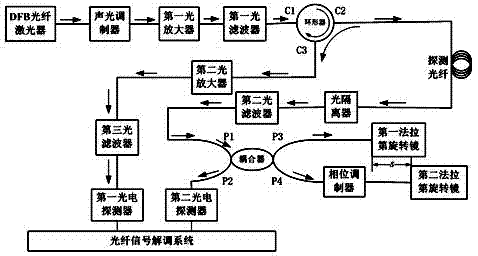Random position point optical fiber distributed sonic sensor
A fiber optic distributed, acoustic wave sensor technology, applied in the direction of measuring ultrasonic/sonic/infrasonic waves, instruments, measuring devices, etc., can solve the problems of complex time division multiplexing technology, measurement range limitation, system cost increase, etc., to reduce technical difficulty, Effect of reducing the required quantity and reducing the system cost
- Summary
- Abstract
- Description
- Claims
- Application Information
AI Technical Summary
Problems solved by technology
Method used
Image
Examples
Embodiment 1
[0031] Example 1 uses a narrow-linewidth, low-noise DFB fiber laser (RFLM-25-3-1550-1, NP Photonics, wavelength 1550nm) as a light source, and then passes through an acousto-optic modulator (ZY-AOM-SM-1550-10 , Beijing Zhongke Ziyu Photoelectric Technology Co., Ltd.) to form a forward incident pulse, and then pass through the first optical amplifier (PB-pluse-EDFA-M-CB-0-0-FC / APC, Beijing Better Optical Technology Co., Ltd. ) and incident to the circulator C1 end after the first optical filter. The C2 end of the circulator is connected to the detection fiber. The detection fiber is an ordinary fiber, assuming that the length of the sensing fiber is 2 km and the pulse width τ of the laser pulse is 50 ns, then the spatial resolution ΔL is 5 m as mentioned above. The Rayleigh backscattering signal of the detection fiber passes through the C3 end of the circulator, passes through the second optical amplifier and the third optical filter, and then directly enters the first photode...
PUM
 Login to View More
Login to View More Abstract
Description
Claims
Application Information
 Login to View More
Login to View More - R&D
- Intellectual Property
- Life Sciences
- Materials
- Tech Scout
- Unparalleled Data Quality
- Higher Quality Content
- 60% Fewer Hallucinations
Browse by: Latest US Patents, China's latest patents, Technical Efficacy Thesaurus, Application Domain, Technology Topic, Popular Technical Reports.
© 2025 PatSnap. All rights reserved.Legal|Privacy policy|Modern Slavery Act Transparency Statement|Sitemap|About US| Contact US: help@patsnap.com



